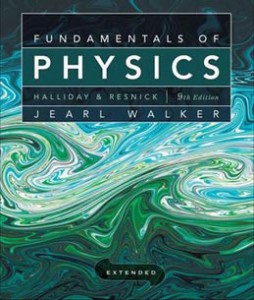Test Bank for Fundamentals of Physics Extended, 9th Edition: Halliday
$35.00 Original price was: $35.00.$26.50Current price is: $26.50.
Test Bank for Fundamentals of Physics Extended, 9th Edition: Halliday
Instant download Test Bank for Fundamentals of Physics Extended, 9th Edition: Halliday pdf docx epub after payment.

Product details:
- ISBN-10 : 0470556536
- ISBN-13 : 978-0470556535
- Author: David Halliday; Robert Resnick; , Jearl Walker
This book arms engineers with the tools to apply key physics concepts in the field. A number of the key figures in the new edition are revised to provide a more inviting and informative treatment. The figures are broken into component parts with supporting commentary so that they can more readily see the key ideas. Material from The Flying Circus is incorporated into the chapter opener puzzlers, sample problems, examples and end-of-chapter problems to make the subject more engaging. Checkpoints enable them to check their understanding of a question with some reasoning based on the narrative or sample problem they just read. Sample Problems also demonstrate how engineers can solve problems with reasoned solutions.
Table of contents:
- Chapter 1: Measurement
- 1.1: What is Physics?
- 1.2: Measuring Things
- 1.3: The International System of Units
- 1.4: Changing Units
- 1.5: Length (9)
- 1.6: Time (8)
- 1.7: Mass (12)
- 1: Additional Problems (19)
- Extra Problems
- Extra Problems
- Extra Problems
- Extra Problems
- Extra Problems
- Extra Problems (6)
- Testbank (27)
- Symbolic Notation
- Simulations
- Conceptual Questions
- Chapter 2: Motion Along a Straight Line
- 2.1: What is Physics?
- 2.2: Motion
- 2.3: Position and Displacement
- 2.4: Average Velocity and Average Speed (11)
- 2.5: Instantaneous Velocity and Speed (3)
- 2.6: Acceleration (5)
- 2.7: Constant Acceleration: A special Case (18)
- 2.8: Another Look at Constant Acceleration
- 2.9: Free-Fall Acceleration (17)
- 2.10: Graphical Integration in Motion Analysis (2)
- 2: Additional Problems (22)
- 2: Guided Online Tutorials (10)
- Extra Problems
- Extra Problems
- Extra Problems
- Extra Problems
- Extra Problems
- Extra Problems (9)
- Testbank (77)
- Symbolic Notation (3)
- Simulations (8)
- Conceptual Questions (4)
- Chapter 3: Vectors
- 3.1: What is Physics?
- 3.2: Vectors and Scalars
- 3.3: Adding Vectors Geometrically
- 3.4: Components of Vectors (7)
- 3.5: Unit Vectors
- 3.6: Adding Vectors by Components (18)
- 3.7: Vectors and the Laws of Physics (1)
- 3.8: Multiplying Vectors (11)
- 3: Additional Problems (20)
- 3: Guided Online Tutorials (7)
- Extra Problems
- Extra Problems
- Extra Problems
- Extra Problems
- Extra Problems
- Extra Problems (7)
- Testbank (39)
- Symbolic Notation
- Simulations (2)
- Conceptual Questions (8)
- Chapter 4: Motion in Two and Three Dimensions
- 4.1: What is Physics?
- 4.2: Position and Displacement (4)
- 4.3: Average Velocity and Instantaneous Velocity (6)
- 4.4: Average Acceleration and Instantaneous Acceleration (9)
- 4.5: Projectile Motion
- 4.6: Projectile Motion Analyzed (22)
- 4.7: Uniform Circular Motion (9)
- 4.8: Relative Motion in One Dimension (3)
- 4.9: Relative Motion in Two Dimensions (7)
- 4: Additional Problems (27)
- 4: Guided Online Tutorials (12)
- Extra Problems
- Extra Problems
- Extra Problems
- Extra Problems
- Extra Problems
- Extra Problems (7)
- Testbank (48)
- Symbolic Notation (5)
- Simulations (4)
- Conceptual Questions (4)
- Chapter 5: Force and Motion – I
- 5.1: What is Physics?
- 5.2: Newtonian Mechanics
- 5.3: Newton’s First Law
- 5.4: Force
- 5.5: Mass
- 5.6: Newton’s Second Law (10)
- 5.7: Some Particular Forces (3)
- 5.8: Newton’s Third Law
- 5.9: Applying Newton’s Laws (38)
- 5: Additional Problems (22)
- 5: Guided Online Tutorials (9)
- Extra Problems
- Extra Problems
- Extra Problems
- Extra Problems
- Extra Problems
- Extra Problems (5)
- Testbank (69)
- Symbolic Notation (4)
- Simulations (5)
- Conceptual Questions (6)
- Chapter 6: Force and Motion – II
- 6.1: What is Physics?
- 6.2: Friction
- 6.3: Properties of Friction (26)
- 6.4: The Drag Force and Terminal Speed (3)
- 6.5: Uniform Circular Motion (16)
- 6: Additional Problems (32)
- 6: Guided Online Tutorials (10)
- Extra Problems
- Extra Problems
- Extra Problems
- Extra Problems
- Extra Problems
- Extra Problems (8)
- Testbank (71)
- Symbolic Notation (4)
- Simulations (10)
- Conceptual Questions (7)
- Chapter 7: Kinetic Energy and Work
- 7.1: What is Physics?
- 7.2: What is Energy?
- 7.3: Kinetic Energy (4)
- 7.4: Work
- 7.5: Work and Kinetic Energy (8)
- 7.6: Work Done by the Gravitational Force (7)
- 7.7: Work Done by a Spring Force (6)
- 7.8: Work Done by a General Variable Force (5)
- 7.9: Power (10)
- 7: Additional Problems (24)
- 7: Guided Online Tutorials (7)
- Extra Problems
- Extra Problems
- Extra Problems
- Extra Problems
- Extra Problems
- Extra Problems
- Testbank (67)
- Symbolic Notation (4)
- Simulations (2)
- Conceptual Questions (7)
- Chapter 8: Potential Energy and Conservation of Energy
- 8.1: What is Physics?
- 8.2: Work and Potential Energy
- 8.3: Path Independence of Conservative Forces
- 8.4: Determining Potential Energy Values (7)
- 8.5: Conservation of Mechanical Energy (23)
- 8.6: Reading a Potential Energy Curve (2)
- 8.7: Work Done on a System by an External Force (4)
- 8.8: Conservation of Energy (15)
- 8: Additional Problems (45)
- 8: Guided Online Tutorials (11)
- Extra Problems
- Extra Problems
- Extra Problems
- Extra Problems
- Extra Problems
- Extra Problems (6)
- Testbank (61)
- Symbolic Notation (6)
- Simulations
- Conceptual Questions (6)
- Chapter 9: Center of Mass and Linear Momentum
- 9.1: What is Physics?
- 9.2: The Center of Mass (7)
- 9.3: Newton’s Second Law for a System of Particles (9)
- 9.4: Linear Momentum
- 9.5: The Linear Momentum of a System of Particles (4)
- 9.6: Collision and Impulse (13)
- 9.7: Conservation of Linear Momentum (8)
- 9.8: Momentum and Kinetic Energy in Collisions
- 9.9: Inelastic Collisions in One Dimension (9)
- 9.10: Elastic Collisions in One Dimension (11)
- 9.11: Collisions in Two Dimensions (4)
- 9.12: Systems with Varying Mass: A Rocket (4)
- 9: Additional Problems (40)
- 9: Guided Online Tutorials (12)
- Extra Problems
- Extra Problems
- Extra Problems
- Extra Problems
- Extra Problems
- Extra Problems (14)
- Testbank (108)
- Symbolic Notation (5)
- Simulations (6)
- Conceptual Questions (9)
- Chapter 10: Rotation
- 10.1: What is Physics?
- 10.2: The Rotational Variables (7)
- 10.3: Are Angular Quantities Vectors?
- 10.4: Rotation with Constant Angular Acceleration (9)
- 10.5: Relating the Linear and Angular Variables (14)
- 10.6: Kinetic Energy of Rotation (2)
- 10.7: Calculating the Rotational Inertia (9)
- 10.8: Torque (4)
- 10.9: Newton’s Second Law for Rotation (6)
- 10.10: Work and Rotational Kinetic Energy (10)
- 10: Additional Problems (27)
- 10: Guided Online Tutorials (9)
- Extra Problems
- Extra Problems
- Extra Problems
- Extra Problems
- Extra Problems
- Extra Problems (10)
- Testbank (82)
- Symbolic Notation (5)
- Simulations (6)
- Conceptual Questions (7)
- Chapter 11: Rolling, Torque, and Angular Momentum
- 11.1: What is Physics?
- 11.2: Rolling as Translation and Rotation Combined (2)
- 11.3: The Kinetic Energy of Rolling
- 11.4: The Forces of Rolling (12)
- 11.5: The Yo-Yo (2)
- 11.6: Torque Revisited (7)
- 11.7: Angular Momentum (6)
- 11.8: Newton’s Second Law in Angular Form (3)
- 11.9: The Angular Momentum of a System of Particles
- 11.10: The Angular Momentum of a Rigid Body Rotating About a Fixed Axis (5)
- 11.11: Conservation of Angular Momentum (21)
- 11.12: Precession of a Gyroscope (1)
- 11: Additional Problems (23)
- 11: Guided Online Tutorials (8)
- Extra Problems
- Extra Problems
- Extra Problems
- Extra Problems
- Extra Problems
- Extra Problems (3)
- Testbank (54)
- Symbolic Notation (6)
- Simulations
- Conceptual Questions (7)
- Chapter 12: Equilibrium and Elasticity
- 12.1: What is Physics?
- 12.2: Equilibrium
- 12.3: The Requirements of Equilibrium
- 12.4: The Center of Gravity
- 12.5: Some Examples of Static Equilibrium (28)
- 12.6: Indeterminate Structures
- 12.7: Elasticity (5)
- 12: Additional Problems (18)
- 12: Guided Online Tutorials (7)
- Extra Problems
- Extra Problems
- Extra Problems
- Extra Problems
- Extra Problems
- Extra Problems (2)
- Testbank (53)
- Symbolic Notation (6)
- Simulations (2)
- Conceptual Questions (3)
- Chapter 13: Gravitation
- 13.1: What is Physics?
- 13.2: Newton’s Law of Gravitation (4)
- 13.3: Gravitation and the Principle of Superposition (6)
- 13.4: Gravitation Near Earth’s Surface (5)
- 13.5: Gravitation Inside Earth (3)
- 13.6: Gravitation Potential Energy (10)
- 13.7: Planets and Satellites: Kepler’s Laws (12)
- 13.8: Satellites: Orbits and Energy (4)
- 13.9: Einstein and Gravitation (1)
- 13: Additional Problems (14)
- 13: Guided Online Tutorials (7)
- Extra Problems
- Extra Problems
- Extra Problems
- Extra Problems
- Extra Problems
- Extra Problems (4)
- Testbank (56)
- Symbolic Notation (5)
- Simulations (1)
- Conceptual Questions (3)
- Chapter 14: Fluids
- 14.1: What is Physics?
- 14.2: What is a Fluid?
- 14.3: Density and Pressure (6)
- 14.4: Fluids at Rest (8)
- 14.5: Measuring Pressure (2)
- 14.6: Pascal’s Principle
- 14.7: Archimedes’ Principle (11)
- 14.8: Ideal Fluids in Motion
- 14.9: The Equation of Continuity (4)
- 14.10: Bernoulli’s Equation (5)
- 14: Additional Problems (7)
- 14: Guided Online Tutorials (5)
- Extra Problems
- Extra Problems
- Extra Problems
- Extra Problems
- Extra Problems
- Extra Problems
- Testbank (85)
- Symbolic Notation (5)
- Simulations
- Conceptual Questions (2)
- Chapter 15: Oscillations
- 15.1: What is Physics?
- 15.2: Simple Harmonic Motion
- 15.3: The Force Law for Simple Harmonic Motion (18)
- 15.4: Energy in Simple Harmonic Motion (7)
- 15.5: An Angular Simple Harmonic Oscillator (2)
- 15.6: Pendulums (7)
- 15.7: Simple Harmonic Motion and Uniform Circular Motion
- 15.8: Damped Simple Harmonic Motion (3)
- 15.9: Forced Oscillations and Resonance (1)
- 15: Additional Problems (22)
- 15: Guided Online Tutorials (11)
- Extra Problems
- Extra Problems
- Extra Problems
- Extra Problems
- Extra Problems
- Extra Problems (2)
- Testbank (62)
- Symbolic Notation (5)
- Simulations (1)
- Conceptual Questions (4)
- Chapter 16: Waves – I
- 16.1: What is Physics?
- 16.2: Types of Waves
- 16.3: Transverse and Longitudinal Waves
- 16.4: Wavelength and Frequency
- 16.5: The Speed of a Traveling Wave (7)
- 16.6: Wave Speed on a Stretched String (9)
- 16.7: Energy and Power of a Wave Traveling Along a String (1)
- 16.8: The Wave Equation (2)
- 16.9: The Principle of Superposition for Waves
- 16.10: Interference of Waves (2)
- 16.11: Phasors (2)
- 16.12: Standing Waves
- 16.13: Standing Waves and Resonance (16)
- 16: Additional Problems (19)
- 16: Guided Online Tutorials (4)
- Extra Problems
- Extra Problems
- Extra Problems
- Extra Problems
- Extra Problems
- Extra Problems
- Testbank (71)
- Symbolic Notation (5)
- Simulations (6)
- Conceptual Questions (1)
- Chapter 17: Waves – II
- 17.1: What is Physics?
- 17.2: Sound Waves
- 17.3: The Speed of Sound (5)
- 17.4: Traveling Sound Waves (3)
- 17.5: Interference (4)
- 17.6: Intensity and Sound Level (9)
- 17.7: Sources of Musical Sound (8)
- 17.8: Beats (4)
- 17.9: The Doppler Effect (8)
- 17.10: Supersonic Speeds, Shock Waves (1)
- 17: Additional Problems (16)
- 17: Guided Online Tutorials (6)
- Extra Problems
- Extra Problems
- Extra Problems
- Extra Problems
- Extra Problems
- Extra Problems
- Testbank (61)
- Symbolic Notation (5)
- Simulations (4)
- Conceptual Questions (1)
- Chapter 18: Temperature, Heat, and the First Law of Thermodynamics
- 18.1: What is Physics?
- 18.2: Temperature
- 18.3: The Zeroth Law of Thermodynamics
- 18.4: Measuring Temperature (1)
- 18.5: The Celsius and Fahrenheit Scales (2)
- 18.6: Thermal Expansion (8)
- 18.7: Temperature and Heat
- 18.8: The Absorption of Heat by Solids and Liquids (14)
- 18.9: A Closer Look at Heat and Work
- 18.10: The First Law of Thermodynamics
- 18.11: Some Special Cases of the First Law of Thermodynamics (4)
- 18.12: Heat Transfer Mechanisms (8)
- 18: Additional Problems (8)
- 18: Guided Online Tutorials (9)
- Extra Problems
- Extra Problems
- Extra Problems
- Extra Problems
- Extra Problems
- Extra Problems
- Testbank (82)
- Symbolic Notation (5)
- Simulations (2)
- Conceptual Questions (1)
- Chapter 19: The Kinetic Theory of Gases
- 19.1: What is Physics?
- 19.2: Avogadro’s Number (2)
- 19.3: Ideal Gases (9)
- 19.4: Pressure, Temperature, and RMS Speed (6)
- 19.5: Translational Kinetic Energy (2)
- 19.6: Mean Free Path (3)
- 19.7: The Distribution of Molecular Speeds (3)
- 19.8: The Molar Specific Heats of an Ideal Gas (3)
- 19.9: Degrees of Freedom and Molar Specific Heats (2)
- 19.10: A Hint of Quantum Theory
- 19.11: The Adiabatic Expansion of an Ideal Gas (4)
- 19: Additional Problems (7)
- 19: Guided Online Tutorials (9)
- Extra Problems
- Extra Problems
- Extra Problems
- Extra Problems
- Extra Problems
- Extra Problems (1)
- Testbank (96)
- Symbolic Notation (5)
- Simulations
- Conceptual Questions (1)
- Chapter 20: Entropy and the Second Law of Thermodynamics
- 20.1: What is Physics?
- 20.2: Irreversible Processes and Entropy
- 20.3: Change in Entropy (11)
- 20.4: The Second Law of Thermodynamics
- 20.5: Entropy in the Real World: Engines (6)
- 20.6: Entropy in the Real World: Refrigerators (6)
- 20.7: The Efficiencies of Real Engines
- 20.8: A Statistical View of Entropy
- 20: Additional Problems (9)
- 20: Guided Online Tutorials (8)
- Extra Problems
- Extra Problems
- Extra Problems
- Extra Problems
- Extra Problems
- Extra Problems
- Testbank (56)
- Symbolic Notation (5)
- Simulations
- Conceptual Questions (1)
People also search:
Fundamentals of Physics Extended
Fundamentals of Physics Extended Halliday
Fundamentals of Physics Extended Halliday 9th
Fundamentals of Physics Extended Halliday 9th Test Bank
Test Bank for Fundamentals of Physics Extended, 9th Edition: Halliday Download
Related products
Test Bank
Test Bank for Essentials of Business Law and the Legal Environment, 11th Edition: Richard A. Mann
Test Bank
Test Bank for Operating Systems: Internals and Design Principles, 7th Edition: William Stallings











